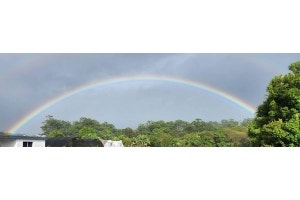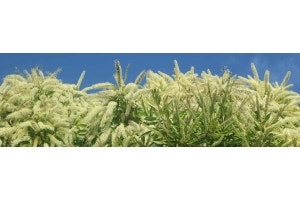"I sit beside the fire and think
Of all that I have seen
Of meadow flowers and butterflies
In summers that have been
Of yellow leaves and gossamer
In autumns that there were
With morning mist and silver sun
And wind upon my hair"
If (like JRR Tolkein) you are hankering for a taste of "yellow leaves and gossamer" in your garden, there are a number of deciduous trees and shrubs that grow very well in many Australian climates, to give you autumn colour as the days cool and the nights lengthen. And if you live somewhere tropical where the days don't cool all that much, discover our recommendations for evergreen plants with coloured leaves, that will give you that toasty misty spice-coloured feeling that Tolkein dreamed of - even when it's far too hot to sit beside the fire.
Autumn Tree Colour
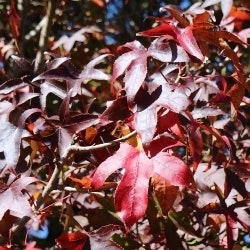 Liquidambars - sweet gums
Liquidambars - sweet gums - are just starting to colour at the beginning of March in gardens around our nursery, as temperatures cool here on the Sunshine Coast. It makes the drive to work more interesting, watching them gently change from green to copper to maroon each day. Sweet gums are a large tree, best for bigger suburban gardens, with a shapely teardrop silhouette and big green hand-shaped leaves like a maple tree. Their colour range is very varied; some trees are honey-gold, some red-orange, some very deep plum-purple. They grow happily in subtropical gardens, and are completely frost-hardy too; they only need a neutral to acid soil and regular water to do well.
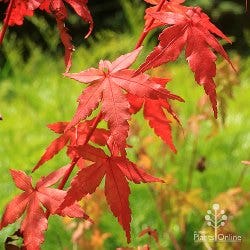
Renowned for their range of rich autumn leaf colour,
Japanese acers are putting on a show right about now with shades of ochre, sand, peach, coral, and rust. Their stems often glow in ruby tones long after the leaves have fallen, giving you an extra season of interest until the fresh spring leaves emerge. Japanese acers love a humus-rich soil on the acid side, where they'll develop their best colour; and a sheltered spot away from scorching sun and drying winds. If you don't have these conditions, they're happy growing in pots too, where they'll stay smaller in size.
 Birch trees
Birch trees are ideal for lighter, more alkaline soils, displaying a waterfall of bright golden foliage in autumn before their leaves fall, and bright white trunks through winter. They are slender trees with delicate airy canopies; so even in a small garden they won't dominate or block the light. If you have the option, site them where you can see the white bark trunks in winter - and plant spring-flowering bulbs underneath. The bulbs will appreciate the extra light in the growing season, and benefit from the tree's leafy shade in the heat of summer.

Year Round Tree Colour
Liquidambars, acers, and birches will start to colour up in autumn, even in mild subtropical locations like the Sunshine Coast. There's just enough difference between day and night temperatures to trigger the change. In warmer locations and sheltered spots you might want to accentuate that seasonal colour change with year-round brightly-coloured foliage. Add a native
gold honey myrtle into the mix; the rounded conical silhouette and fine slender vibrant foliage make it showy in every month, without being pushy; and the luminous lime-golden colour contrasting with red stems is perfect for conjuring a sense of autumn.
Autumn Shrub Colour
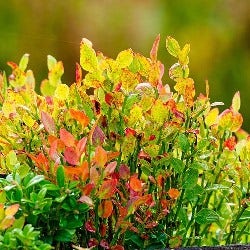
If you don't have room for a tree, or you want to replicate all that arboreal splendour on a lower level, there's heaps of shrubs that show off at this time of year.
One plant you may not think about when it comes to autumn colour is the
blueberry. Hugely popular for pretty pale pink flowers, and of course those juicy nutritious fruits, blueberries are valuable additions to the autumn garden as their small leaves blaze as brightly as a bonfire when the weather gets cold.They like a neutral to acid soil and access to regular moisture to grow those succulent berries. New varieties like Sunshine Blue and Misty have been bred to set fruit in warmer climates; Brightwell and Powder Blue will enjoy a cooler winter.

Hedging Viburnums like Dense Fence and Emerald Lustre are usually known for their new young leaf colour, in rich coppery shades. (There's even a new variety called
Coppertop!)If you choose the deciduous white-flowering
viburnum Lanarth, its neat pleated foliage takes on warm chestnut-brown tones in cooler weather, like a fine brandy.Bright and neat and compact, and very rich in colour all year round, wine-red
berberis takes on a deeper tone in autumn-winter, and makes excellent dense hedging for boundaries and for wildlife shelter. Tiny golden bell flowers contrast with the leaves in spring-summer, followed by small red berries which hungry birds will appreciate.

If you wish the colours of autumn could go on all year, then
Nandina - sacred bamboo - is the plant for you. Their leaves ripple through the rainbow, sometimes green, sometimes gold, then turning brilliant red or coral or burgundy all over in colder months. Tough, resilient, neat, clippable into tidy hedges - no wonder they're so popular.
Ozbreed varieties Blush™, Flirt™ and Obsession™ will give you rich deep plum-ruby-burgundy tones; Gulf Stream and Moonbay glow at the other end of the spectrum in lime-coral-peach shades. Nandina nana and Firepower shine in traffic-light blends of red, amber, and green.
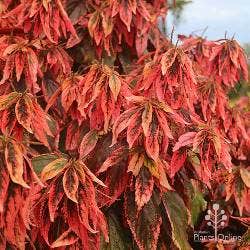
Year Round Shrub Colour
For full-on foliage colour that's not so familiar, we suggest Acalypha. These soft-leaved shrubs make dramatic feature plants by themselves and very eyecatching informal hedges when planted en masse. Acalypha will need a frost-free garden, but as a tropical alternative to Japanese acer they're pretty unbeatable.
Firestorm is small and compact, with a rainbow of shades on each leaf; while bigger, bolder
Inferno has graduated shading like an autumn sunset.
Autumn Groundcover Colour

The round glossy leaves of frost-hardy
Bergenia Flirt take on warm shades of wine, plum, and cherry when temperatures start to fall.Bergenias originate from Siberia so no matter how cold or windy your garden gets, this plant can cope. In hot places it appreciates more water and a shady spot - ideal for urban gardens which might not get much sunshine - and it doesn't mind poor soil.The lovely leaf colour alone is enough to recommend this plant, but in later winter-early spring it also produces abundant clusters of deep pink flowers to brighten garden borders when they need it most.

Plant bergenia in the shadier spots in your garden, and complement it in the sunnier spots with rugged Limonium perezii -
sea lavender. Sea lavender's more matt, rippled rosettes of leaves develop spicy shades of paprika and chili during autumn in response to cooler weather. They also shake off sea breezes and salt spray, and love Aussie sunshine. Like bergenia, sea lavender grow in poor soils, even dry sandy ones; and in summer long stems of papery purple and white flowers appear. These two rugged easycare plants will give you long months of enjoyment from buds and flowers to leaf colour.

Year Round Groundcover Colour
For low growing plants with high colour impact, you can't go past
alternanthera in a frost free garden. The deep plum purple Little Ruby is most well known, but the pumpkin-spicy shades of
Tricolour and the glowing wine red of
Brazilian Red Hots™ will give you a real autumn feel.Alternanthera are fast-growing, and you can either let them romp about or clip them regularly to keep them neat and compact.

You may not be familiar with
heuchera and
heucherella, which are lovely flowering groundcovers for dappled shade or part sun. Very popular in their native USA and in Europe, they are frost hardy, so they're happy in southern and hinterland gardens as well as northern and coastal ones. There's been a lot of new varieties bred recently to meet demand for these pretty groundcovers: the palette ranges from deep plummy-black and patterned green-maroon through reds, oranges, wine-pinks and toffee yellows, to silver. Something for every taste!

 Liquidambars - sweet gums - are just starting to colour at the beginning of March in gardens around our nursery, as temperatures cool here on the Sunshine Coast. It makes the drive to work more interesting, watching them gently change from green to copper to maroon each day. Sweet gums are a large tree, best for bigger suburban gardens, with a shapely teardrop silhouette and big green hand-shaped leaves like a maple tree. Their colour range is very varied; some trees are honey-gold, some red-orange, some very deep plum-purple. They grow happily in subtropical gardens, and are completely frost-hardy too; they only need a neutral to acid soil and regular water to do well.
Liquidambars - sweet gums - are just starting to colour at the beginning of March in gardens around our nursery, as temperatures cool here on the Sunshine Coast. It makes the drive to work more interesting, watching them gently change from green to copper to maroon each day. Sweet gums are a large tree, best for bigger suburban gardens, with a shapely teardrop silhouette and big green hand-shaped leaves like a maple tree. Their colour range is very varied; some trees are honey-gold, some red-orange, some very deep plum-purple. They grow happily in subtropical gardens, and are completely frost-hardy too; they only need a neutral to acid soil and regular water to do well.
 Renowned for their range of rich autumn leaf colour, Japanese acers are putting on a show right about now with shades of ochre, sand, peach, coral, and rust. Their stems often glow in ruby tones long after the leaves have fallen, giving you an extra season of interest until the fresh spring leaves emerge. Japanese acers love a humus-rich soil on the acid side, where they'll develop their best colour; and a sheltered spot away from scorching sun and drying winds. If you don't have these conditions, they're happy growing in pots too, where they'll stay smaller in size.
Renowned for their range of rich autumn leaf colour, Japanese acers are putting on a show right about now with shades of ochre, sand, peach, coral, and rust. Their stems often glow in ruby tones long after the leaves have fallen, giving you an extra season of interest until the fresh spring leaves emerge. Japanese acers love a humus-rich soil on the acid side, where they'll develop their best colour; and a sheltered spot away from scorching sun and drying winds. If you don't have these conditions, they're happy growing in pots too, where they'll stay smaller in size.
 Birch trees are ideal for lighter, more alkaline soils, displaying a waterfall of bright golden foliage in autumn before their leaves fall, and bright white trunks through winter. They are slender trees with delicate airy canopies; so even in a small garden they won't dominate or block the light. If you have the option, site them where you can see the white bark trunks in winter - and plant spring-flowering bulbs underneath. The bulbs will appreciate the extra light in the growing season, and benefit from the tree's leafy shade in the heat of summer.
Birch trees are ideal for lighter, more alkaline soils, displaying a waterfall of bright golden foliage in autumn before their leaves fall, and bright white trunks through winter. They are slender trees with delicate airy canopies; so even in a small garden they won't dominate or block the light. If you have the option, site them where you can see the white bark trunks in winter - and plant spring-flowering bulbs underneath. The bulbs will appreciate the extra light in the growing season, and benefit from the tree's leafy shade in the heat of summer.

 If you don't have room for a tree, or you want to replicate all that arboreal splendour on a lower level, there's heaps of shrubs that show off at this time of year.
One plant you may not think about when it comes to autumn colour is the blueberry. Hugely popular for pretty pale pink flowers, and of course those juicy nutritious fruits, blueberries are valuable additions to the autumn garden as their small leaves blaze as brightly as a bonfire when the weather gets cold.They like a neutral to acid soil and access to regular moisture to grow those succulent berries. New varieties like Sunshine Blue and Misty have been bred to set fruit in warmer climates; Brightwell and Powder Blue will enjoy a cooler winter.
If you don't have room for a tree, or you want to replicate all that arboreal splendour on a lower level, there's heaps of shrubs that show off at this time of year.
One plant you may not think about when it comes to autumn colour is the blueberry. Hugely popular for pretty pale pink flowers, and of course those juicy nutritious fruits, blueberries are valuable additions to the autumn garden as their small leaves blaze as brightly as a bonfire when the weather gets cold.They like a neutral to acid soil and access to regular moisture to grow those succulent berries. New varieties like Sunshine Blue and Misty have been bred to set fruit in warmer climates; Brightwell and Powder Blue will enjoy a cooler winter.
 Hedging Viburnums like Dense Fence and Emerald Lustre are usually known for their new young leaf colour, in rich coppery shades. (There's even a new variety called Coppertop!)If you choose the deciduous white-flowering viburnum Lanarth, its neat pleated foliage takes on warm chestnut-brown tones in cooler weather, like a fine brandy.Bright and neat and compact, and very rich in colour all year round, wine-red berberis takes on a deeper tone in autumn-winter, and makes excellent dense hedging for boundaries and for wildlife shelter. Tiny golden bell flowers contrast with the leaves in spring-summer, followed by small red berries which hungry birds will appreciate.
Hedging Viburnums like Dense Fence and Emerald Lustre are usually known for their new young leaf colour, in rich coppery shades. (There's even a new variety called Coppertop!)If you choose the deciduous white-flowering viburnum Lanarth, its neat pleated foliage takes on warm chestnut-brown tones in cooler weather, like a fine brandy.Bright and neat and compact, and very rich in colour all year round, wine-red berberis takes on a deeper tone in autumn-winter, and makes excellent dense hedging for boundaries and for wildlife shelter. Tiny golden bell flowers contrast with the leaves in spring-summer, followed by small red berries which hungry birds will appreciate.
 If you wish the colours of autumn could go on all year, then Nandina - sacred bamboo - is the plant for you. Their leaves ripple through the rainbow, sometimes green, sometimes gold, then turning brilliant red or coral or burgundy all over in colder months. Tough, resilient, neat, clippable into tidy hedges - no wonder they're so popular. Ozbreed varieties Blush™, Flirt™ and Obsession™ will give you rich deep plum-ruby-burgundy tones; Gulf Stream and Moonbay glow at the other end of the spectrum in lime-coral-peach shades. Nandina nana and Firepower shine in traffic-light blends of red, amber, and green.
If you wish the colours of autumn could go on all year, then Nandina - sacred bamboo - is the plant for you. Their leaves ripple through the rainbow, sometimes green, sometimes gold, then turning brilliant red or coral or burgundy all over in colder months. Tough, resilient, neat, clippable into tidy hedges - no wonder they're so popular. Ozbreed varieties Blush™, Flirt™ and Obsession™ will give you rich deep plum-ruby-burgundy tones; Gulf Stream and Moonbay glow at the other end of the spectrum in lime-coral-peach shades. Nandina nana and Firepower shine in traffic-light blends of red, amber, and green.

 The round glossy leaves of frost-hardy Bergenia Flirt take on warm shades of wine, plum, and cherry when temperatures start to fall.Bergenias originate from Siberia so no matter how cold or windy your garden gets, this plant can cope. In hot places it appreciates more water and a shady spot - ideal for urban gardens which might not get much sunshine - and it doesn't mind poor soil.The lovely leaf colour alone is enough to recommend this plant, but in later winter-early spring it also produces abundant clusters of deep pink flowers to brighten garden borders when they need it most.
The round glossy leaves of frost-hardy Bergenia Flirt take on warm shades of wine, plum, and cherry when temperatures start to fall.Bergenias originate from Siberia so no matter how cold or windy your garden gets, this plant can cope. In hot places it appreciates more water and a shady spot - ideal for urban gardens which might not get much sunshine - and it doesn't mind poor soil.The lovely leaf colour alone is enough to recommend this plant, but in later winter-early spring it also produces abundant clusters of deep pink flowers to brighten garden borders when they need it most.
 Plant bergenia in the shadier spots in your garden, and complement it in the sunnier spots with rugged Limonium perezii - sea lavender. Sea lavender's more matt, rippled rosettes of leaves develop spicy shades of paprika and chili during autumn in response to cooler weather. They also shake off sea breezes and salt spray, and love Aussie sunshine. Like bergenia, sea lavender grow in poor soils, even dry sandy ones; and in summer long stems of papery purple and white flowers appear. These two rugged easycare plants will give you long months of enjoyment from buds and flowers to leaf colour.
Plant bergenia in the shadier spots in your garden, and complement it in the sunnier spots with rugged Limonium perezii - sea lavender. Sea lavender's more matt, rippled rosettes of leaves develop spicy shades of paprika and chili during autumn in response to cooler weather. They also shake off sea breezes and salt spray, and love Aussie sunshine. Like bergenia, sea lavender grow in poor soils, even dry sandy ones; and in summer long stems of papery purple and white flowers appear. These two rugged easycare plants will give you long months of enjoyment from buds and flowers to leaf colour.

 You may not be familiar with heuchera and heucherella, which are lovely flowering groundcovers for dappled shade or part sun. Very popular in their native USA and in Europe, they are frost hardy, so they're happy in southern and hinterland gardens as well as northern and coastal ones. There's been a lot of new varieties bred recently to meet demand for these pretty groundcovers: the palette ranges from deep plummy-black and patterned green-maroon through reds, oranges, wine-pinks and toffee yellows, to silver. Something for every taste!
You may not be familiar with heuchera and heucherella, which are lovely flowering groundcovers for dappled shade or part sun. Very popular in their native USA and in Europe, they are frost hardy, so they're happy in southern and hinterland gardens as well as northern and coastal ones. There's been a lot of new varieties bred recently to meet demand for these pretty groundcovers: the palette ranges from deep plummy-black and patterned green-maroon through reds, oranges, wine-pinks and toffee yellows, to silver. Something for every taste!

























